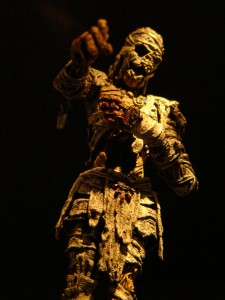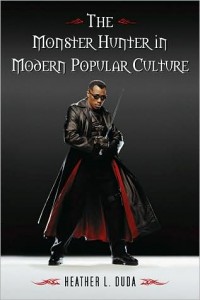 My research and exploration of the fantastic over the last few months has unearthed some interested gems that touch on neglected aspects of horror. These include the book The Mummy’s Curse: Mummymania in the English-Speaking World(Routledge, 2006) by Jasmine Day, a lecturer in Egyptology. Of the various monster archetypes the mummy is one of the most neglected, but Day remedies this in her fine treatment, an adaption of her doctoral dissertation, described as follows on the the back cover of the book:
My research and exploration of the fantastic over the last few months has unearthed some interested gems that touch on neglected aspects of horror. These include the book The Mummy’s Curse: Mummymania in the English-Speaking World(Routledge, 2006) by Jasmine Day, a lecturer in Egyptology. Of the various monster archetypes the mummy is one of the most neglected, but Day remedies this in her fine treatment, an adaption of her doctoral dissertation, described as follows on the the back cover of the book:
“The riddle of the ‘curse of the pharoahs’ is finally solved via a radical anthropological treatment of the legend as a cultural concept rather than a physical phenomenon. The most penetrating study of the curse ever conducted shows that its structure and meaning changed over time, as public attitudes towards archaeology and the Middle East were transformed by events such as the discovery of Tutankhamun’s tomb. Victorian women writers likened unwrapping to rape, but to exploit the growing popularity of Egyptology, Hollywood turned mummies from victims into monsters, destroying the curse’s power to challenge abuses of human remains. Mummies came to symbolize everything wrong and rotten: pollution, age, death, difference and defiance of authority, becoming imaginary friends or cautionary examples for children.
“The Mummy’s Curseuncovers forgotten nineteenth-century fiction and poetry, revolutionizes the study of mummy horror films and reveals the prejudices embedded in children’s toys. Original surveys and field observations of museum visitors demonstrate that media stereotypes – to which museums inadvertently contribute – promote vilification of mummies, which can invalidate demands for their removal from display. The Mummy’s Curse asks: must we debase other cultures in order to promote our own?”
 The second volume that deals with a neglected aspect of horror is The Monster Hunter in Modern Popular Culture (McFarland, 2008) by Heather Duda. Of course, monsters have received a great deal of attention from readers and viewing audiences throughout the centuries, and most recently from scholars in a variety of disciplines, but Duda points out in her book, based on a revised and expanded form of her doctoral dissertation, that the figure of the monster hunter has been neglected. The back cover of Duda’s book describes its contents:
The second volume that deals with a neglected aspect of horror is The Monster Hunter in Modern Popular Culture (McFarland, 2008) by Heather Duda. Of course, monsters have received a great deal of attention from readers and viewing audiences throughout the centuries, and most recently from scholars in a variety of disciplines, but Duda points out in her book, based on a revised and expanded form of her doctoral dissertation, that the figure of the monster hunter has been neglected. The back cover of Duda’s book describes its contents:
“As monsters in popular media have evolved and grown more complex, so have those who take on the job of stalking and staking them. This book examines the evolution of the contemporary monster hunter from Bram Stoker’s Abraham Van Helsing to today’s non-traditional monster hunters such as Blade, Buffy the Vampire Slayer, and Watchmen.
“Critically surveying a diverse range of books, films, television shows, and graphic novels, this study reveals how the monster hunter began as a white, upper-class, educated male and became everything from a vampire to a teenage girl with supernatural powers. Now often resembling the monsters they’ve vowed to conquer, modern characters occupy a gray area where the battle is often with their own inner natures as much as with the ‘evil’ they fight.”
Look for interviews with both of these authors here in the near future as we explore these neglected and important aspects of horror.





Both of those look quite interesting, but I’m especially curious about the mummy book. I’m in the process of reading (for about 6 months now) the late Edward Said’s “Orientalism” – about the European invention of the savage and mysterious Middle East – and that book seems like it might dovetail nicely. Thanks for the head’s up!